 W
WAkabeko is a legendary cow from the Aizu region of Japan, who inspired a traditional toy. Aizu legend claims that the toys are based on a real cow used to build the Enzō-ji temple of Yanaizu in the ninth century.
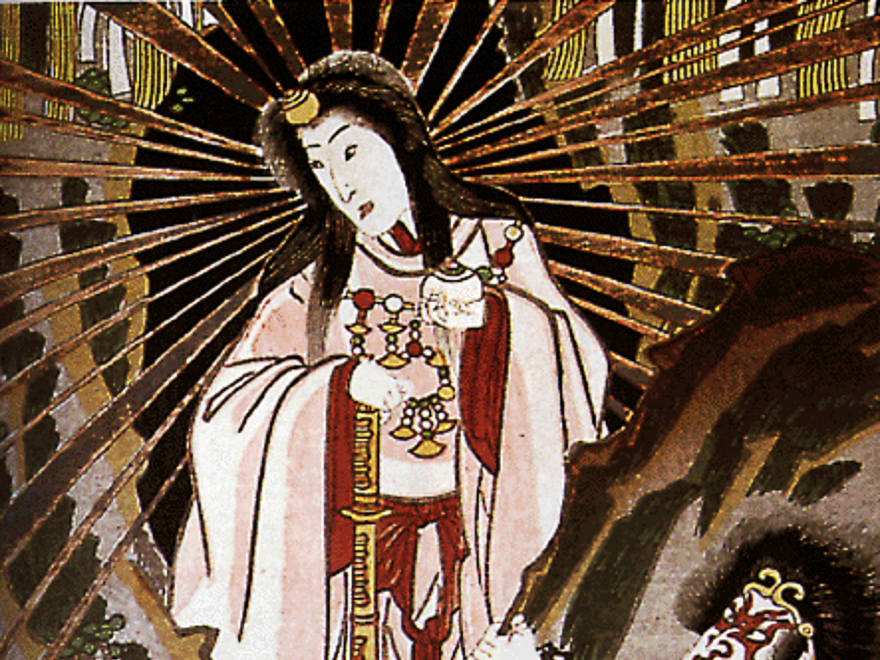 W
WThe akuma (悪魔) is a malevolent fire spirit in Japanese folklore. It is also described as a category of undefined beings who brought afflictions on humans.
 W
WBake-danuki (化け狸) are a kind of yōkai found in the classics and in the folklore and legends of various places in Japan, commonly associated with the Japanese raccoon dog or tanuki.
 W
WBunbuku Chagama, literally "Bunbuku tea-kettle" is a Japanese folktale or fairy tale about a raccoon dog, or tanuki, that uses its shapeshifting powers to reward its rescuer for his kindness.
 W
WZhu Meichu, known by her title Princess Changping, was a Chinese princess of the Ming dynasty. She was one of the children of Chongzhen Emperor and Empress Zhou.
 W
WChūjō-hime was by most accounts a daughter of the court noble Fujiwara no Toyonari who escaped persecution at the hands of her stepmother by becoming a nun at the Taima-dera in Nara. There she took on the name Zenshin-ni or the Dharma name Honyo (法如). She has become a folk heroine, the subject of numerous Japanese folktales which celebrate her filial piety. She is sometimes called the Japanese Cinderella.
 W
WA Daruma doll is a hollow, round, Japanese traditional doll modeled after Bodhidharma, the founder of the Zen tradition of Buddhism. These dolls, though typically red and depicting a bearded man (Bodhidharma), vary greatly in color and design depending on region and artist. Though considered a toy by some, Daruma has a design that is rich in symbolism and is regarded more as a talisman of good luck to the Japanese. Daruma dolls are seen as a symbol of perseverance and good luck, making them a popular gift of encouragement. The doll has also been commercialized by many Buddhist temples to use alongside the setting of goals.
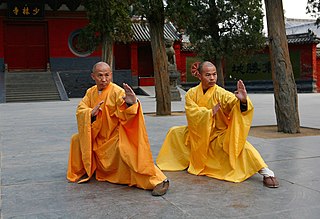 W
WFong Sai-yuk was a Chinese martial artist and folk hero from Zhaoqing City, Guangdong Province of the Qing dynasty.
 W
WHakuzōsu(白蔵主), also written Hakuzosu and Hakuzousu, is the name of a popular kitsune character who pretended to be a priest in Japanese folklore.
 W
WHoichi the Earless is the name of a well-known figure from Japanese folklore. His story is well known in Japan, and the best-known English translation first appeared in the book Kwaidan: Stories and Studies of Strange Things by Lafcadio Hearn.
 W
WHung Hei-gun or Hong Xiguan (1745—1825) was a Chinese martial artist who lived in the Qing dynasty. He was also an influential figure in the Southern Shaolin school of Chinese martial arts. His name is also alternatively romanised as Hung Hei-koon, Hung Hei-kwun, Hung Hsi-kuan, and similar renditions. He was believed to be the creator and founder of Hung Ga Kuen.
 W
WIkiryō , also known as shōryō (しょうりょう), seirei (せいれい), or ikisudama (いきすだま), is a disembodied spirit in Japanese popular belief and fiction that leaves the body of a living person and subsequently haunts other people or places, sometimes across great distances. The term(s) are used in contrast to shiryō, which refers to the spirit of those who are already deceased.
 W
WIssun-bōshi is the subject of a fairy tale from Japan. This story can be found in the old Japanese illustrated book Otogizōshi. Similar central figures and themes are known elsewhere in the world, as in the tradition of Tom Thumb in English folklore.
 W
WJapanese dragons are diverse legendary creatures in Japanese mythology and folklore. Japanese dragon myths amalgamate native legends with imported stories about dragons from China, Korea and India. The style of the dragon was heavily influenced by the Chinese dragon. Like these other East Asian dragons, most Japanese ones are water deities associated with rainfall and bodies of water, and are typically depicted as large, wingless, serpentine creatures with clawed feet. The modern Japanese language has numerous "dragon" words, including indigenous Tatsu from Old Japanese ta-tu, Sino-Japanese ryū or ryō 竜 from Chinese lóng 龍, nāga ナーガ from Sanskrit nāga, and doragon ドラゴン from English "dragon".
 W
WKamishibai is a form of Japanese street theater and storytelling that was popular during the Depression of the 1930s and the post-war period in Japan until the advent of television during the twentieth century. Kamishibai was told by a kamishibaiya who travelled to street corners with sets of illustrated boards that they placed in a miniature stage-like device and narrated the story by changing each image. Kamishibai has its earliest origins in Japanese Buddhist temples where Buddhist monks from the eighth century onward used emakimono as pictorial aids for recounting their history of the monasteries, an early combination of picture and text to convey a story.
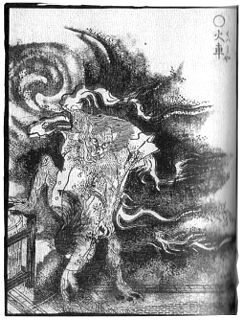 W
WThe kasha is a Japanese yōkai that steals the corpses of those who have died as a result of accumulating evil deeds.
 W
WKiyohime (清姫) in Japanese folklore is a character in the story of Anchin and Kiyohime. In this story, she fell in love with a Buddhist monk named Anchin, but after her interest in the monk was rejected, she chased after him and transformed into a serpent in a rage, before killing him in a bell where he had hidden in the Dōjō-ji temple.
 W
WKurozuka is the grave of an onibaba in Nihonmatsu, Fukushima Prefecture, Adachi District or the legend of that onibaba. It lives in Adachigahara and it is told in legends as the "Onibaba of Adachigahara." The Kurozuka is actually the name of the mound in which this onibaba is buried, but nowadays it can also be used to refer to the onibaba as well. Also based on this legend are the noh titled Kurozuka, the nagauta and kabuki performance Adachigahara, and the kabuki jōruri Ōshū Adachigahara (奥州安達原).
 W
WThe Legend of the White Snake, also known as Madame White Snake, is a Chinese legend. It has since been presented in a number of major Chinese operas, films, and television series.
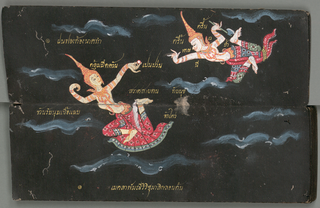 W
WManimekhala is a goddess in the Hindu-Buddhist mythology. She is regarded as a guardian of the seas, namely the Indian Ocean and the South China Sea as part of the mythology of Southeast Asia. She was placed by Cātummahārājika to protect virtuous beings from shipwreck. She appears in several Buddhist stories including the Mahanipata Jataka, in which she rescues Prince Mahajanaka from a shipwreck.
 W
WNang Tani is a female spirit of the Thai folklore. According to folk tradition, this ghost appears as a young woman that haunts wild banana trees, known as in Thai language as Kluai Tani (กล้วยตานี).
 W
WThe Nuribotoke (塗仏) is a yōkai found in Japanese yōkai emaki such as the Hyakkai Zukan by Sawaki Suushi. They are also depicted in the Gazu Hyakki Yagyō by Toriyama Sekien.
 W
WPhosop or Phaisop is the rice goddess of the Thai people. She is a deity more related to ancient Thai folklore than a goddess of a structured, mainstream religion. She is also known as Mae Khwan Khao.
 W
WSanni yakuma, sometimes known as Daha ata sanniyas, is a traditional Sinhalese exorcism ritual. The ritual consists of 18 masked dances, each depicting a particular illness or ailment affecting humans. These 18 dances are the main dances of the Pahatharata, or low country, dancing form, which is one of the three main dancing forms of Sri Lanka. The ritual calls the demons who are thought to affect the patient, who are then told not to trouble humans and banished.
 W
WShin Upagutta is an arahant commonly venerated by Buddhists in Myanmar. He is believed to protect worshipers from danger, including floods and storms. He is also venerated in Northern Thailand and Laos, where he is known as Upakhut.
 W
WSuvannamaccha is a daughter of Tosakanth appearing in the Thai and other Southeast Asian versions of Ramayana. She is a mermaid princess who tries to spoil Hanuman's plans to build a bridge to Lanka but falls in love with him instead.
 W
WThe Tale of the Bamboo Cutter is a monogatari containing elements of Japanese folklore. Written by an unknown author in the late 9th or early 10th century during the Heian period, it is considered the oldest surviving work in the monogatari form.
 W
W[[Image:Kuniyoshi The Dragon Princess.jpg|thumb|240px|Dragon Woman and Tawara Tōda. Centipede of Mt. Mikami (above).{{small|―Utagawa Kuniyoshi 1845, Tokaidō gojūsantsui: Kusatsu]]
 W
WThe Ten Tigers of Canton or Ten Tigers of Guangdong refers to a group of ten Chinese martial artists from Guangdong Province who lived around the 19th century during the Qing dynasty in China. They were said to be the best fighters in southern China at the time. Much of their existence has been embellished by folk legends and stories passed down from generation to generation.
 W
W"The Cowherd and the Weaver Girl" is a romantic Chinese folk tale. The story tells of the romance between Zhinü and Niulang. Their love was not allowed, and thus they were banished to opposite sides of the heavenly river. Once a year, on the seventh day of the seventh lunar month, a flock of magpies would form a bridge to reunite the lovers for a single day. Though there are many variations of the story, the earliest-known reference to this famous myth dates back to a poem from the Classic of Poetry from over 2600 years ago.
 W
WThe legend of The Twelve Sisters or The Twelve Ladies, known as Nang Sip Song (นางสิบสอง) or as Phra Rot Meri (พระรถเมรี) in Thai a Southeast Asian folktale, and also an apocryphal Jātaka Tale, the Rathasena Jātaka of the Paññāsa Jātaka collection. It is one of the stories of the previous lives of Buddha in which Rathasena, the son of one of the twelve women, is the bodhisattva.
 W
WThe three wise monkeys are a Japanese pictorial maxim, embodying the proverbial principle "see no evil, hear no evil, speak no evil". The three monkeys areMizaru, who sees no evil, covering its eyes Kikazaru, who hears no evil, covering its ears, and Iwazaru, who speaks no evil, covering its mouth.
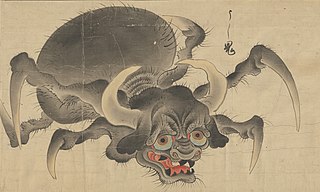 W
WThe Ushi-Oni , or gyūki, is a yōkai from the folklore of western Japan. The folklore describes more than one kind of ushi-oni, but the depiction of a bovine-headed monster occurs in most. Ushi-oni generally appear on beaches and attack people who walk there.
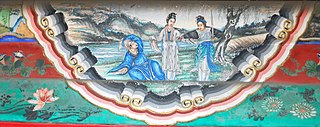 W
WXiaoqing, or Qingqing, is a legendary Chinese folk heroine and main character in the "Legend of the White Snake", one of China's Four Great Folktales.
 W
WZawgyi is a semi-immortal human alchemist and mystic with supernatural powers and often seen with a magic stick and a red hat. Zawgyi is one of the supernatural figures in Burmese mythology and folklore.
 W
WZennyo Ryūō is a rain-god dragon in Japanese mythology. According to Japanese Buddhist tradition, the priest Kūkai made Zennyo Ryūō appear in 824 AD during a famous rainmaking contest at the Kyoto Imperial Palace.
 W
WZhou Tong was the archery teacher and second military arts tutor of famous Song dynasty general Yue Fei. Originally a local hero from Henan, he was hired to continue Yue Fei's military training in archery after the boy had rapidly mastered spearplay under his first teacher. In addition to the future general, Zhou accepted other children as archery pupils. During his tutelage, Zhou taught the children all of his skills and even rewarded Yue with his two favorite bows because he was his best pupil. After Zhou's death, Yue would regularly visit his tomb twice a month and perform unorthodox sacrifices that far surpassed that done for even beloved tutors. Yue later taught what he had learned from Zhou to his soldiers and they were successful in battle.